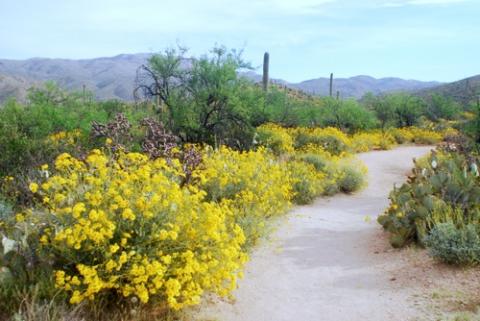For a quick, relatively easy, immersion into Saguaro National Park, the Douglas Spring Trail in the Cactus Forest of the park's Rincon Mountain District is hard to beat. It has it all -- acres of sagaruos of different stature, chattering birds and rattling snakes and, if you time it right, gorgeous wildflowers.
When you first head down this footpath, it almost seems as if you're strolling through a botanical garden. The trail is wide and smooth, lined by all sorts of desert vegetation that explodes in color during the spring bloom, which usually arrives by early-to-mid April. While saguaro sentinels and spindly ocotillos give height to the landscape, lower down you'll find a range of cacti, from prickly pears and fishhook cactus to beavertails, pincushions, and Teddy Bear Chollas, along with sprays of wildflowers.
There are roughly 165 miles of marked trails in Saguaro, and the Cactus Forest is threaded with roughly one-quarter of that total (see attached) with a spider-web of trails that ramble through the Sonoran Desert. There's even a short, 2.5-mile stretch that is open to mountain bikers, though that's too short to truly appreciate what the area offers.
Higher and wetter than the Tucson Mountain District 30 miles to the west on the far side of Tuscon, the Rincon Mountain District on the city's east side is home to nearly 1,200 plant species, more than twice what the Tucson District claims, according to the park. Among the vegetation you'll find here are four species of yucca, four species of amaranth, two species of desertpeony, and more than two dozen species of cacti. And most seemed in bloom when my wife and I hiked the trail in mid-April.
When in bloom all this vegetation daubs the desert with golds and yellows and whites, along with fuscias and blues and reds and oranges.
Through this kaleidoscope of color the Douglas Spring Trail slowly climbs 2.6 miles and 1,110 feet in elevation from the trailhead at the end of Tucson's Speedway Boulevard towards Bridal Wreath Falls. While this waterfall can be gushing at the height of spring runoff, we clearly had missed that peak. When we reached the waterfall it was more like a trickle, but that was enough to nourish delicate sprays of Seepwillow that clung to the hillside.
Heading back to the trailhead, we followed a 1.5-mile section of the Three Tank Trail, a path not as heavily used as Douglas Spring. That was clearly noticeable from the trail's narrower footprint, which brought us uncomfortably close to the desert's wildlife. There was no mistaking the snake's warning: the castanet-like rattle gave us a little jump, and a quick glance spied the rattler not 4 feet off the trail.
But what type of rattler was it? Was it a Black-tailed rattlesnake, a Mohave rattlesnake, a Tiger rattlesnake, a Western diamond-back rattler, or a sidewinder? My money was on it being a Western diamond-back, but I was not about to get any closer to verify that.
Quickly moving past the snake, we reached the junction with the Carrillo Trail and headed 1.3 miles back north to the Douglas Spring Trail. This stretch was easily the most colorful and intriguing of our hike as the path moved up and down, passing through a small grove of ocotillo, their orange-flowered tips glowing like fireplace pokers, and past violet-bloomed Hedgehogs, patches of pink Fairy Dusters, bluish-petaled Scorpionweed, and across a hillside studded with sagaruos and painted in yellow brittlebrush.
Gila monsters also enjoy the Cactus Forest, and while venomous, these slow-ambling reptiles are not as intimidating nor as dangerous as the rattlesnakes.
This 7-mile loop took us roughly four hours at an easy pace with stops for photos and snacks. While we set out from the trailhead at 7:30 a.m., the temperature quickly climbed through the 80s and into the 90s. The locals are well-aware of this, as we passed a few small groups of hikers coming down as we headed up towards Bridal Wreath Falls.
Payoffs: During the spring wildflower bloom the desert is painted in a rainbow of colors.
Cautions: Carry plenty of water, for it gets hot quickly and that, coupled with the desert dryness, can quickly dehydrate you. Watch for rattlers. Don't forget sunscreen or block and a wide-brimmed hat.




Comments
While I did this hike in late fall and never got to enjoy the bloom of the spring wildflowers, I agree that it was a wonderful little hike. Of course, going when I did also made it less likely that I'd come across any rattlers as they had begun to seek their winter 'hibernation' dens.
That is one of the great hikes in Southern AZ!